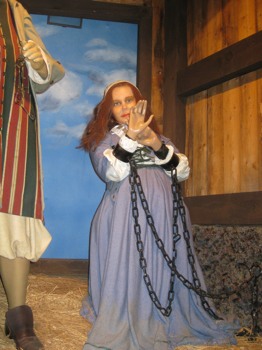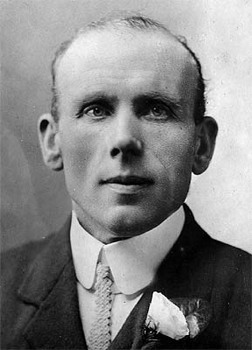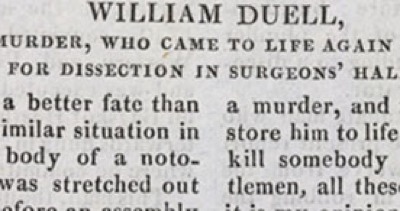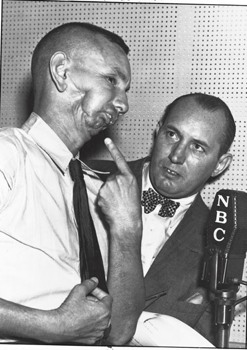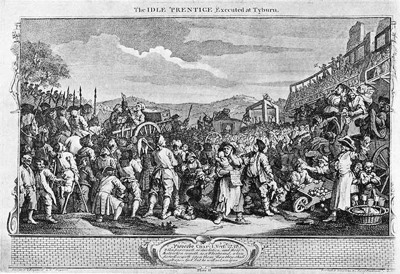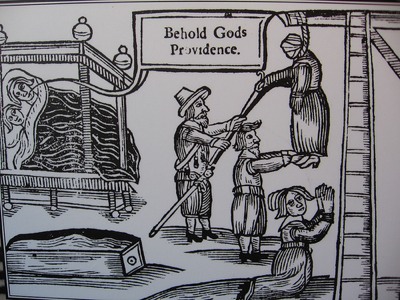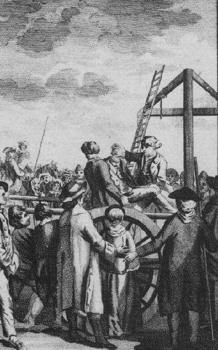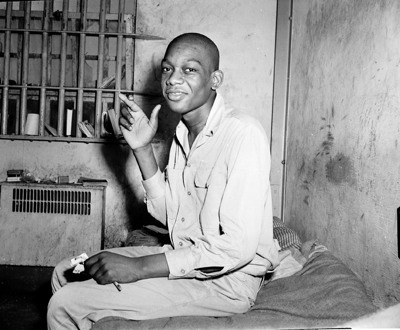 History
History  History
History  Pop Culture
Pop Culture 10 Cases of Grabbing Defeat from the Jaws of Victory
 History
History 10 Common Misconceptions About the Renaissance
 Weird Stuff
Weird Stuff 10 Crazy Things Resulting from Hidden Contract Provisions
 Facts
Facts 10 Unusual Facts About Calories
 Weird Stuff
Weird Stuff 10 Days of Humiliation When the Person Should Have Stayed in Bed
 Humans
Humans 10 Surprising Ways Game Theory Rules Your Daily Life
 Food
Food 10 Popular (and Weird) Ancient Foods
 Animals
Animals Ten Bizarre Creatures from Beneath the Waves
 Technology
Technology 10 Unexpected Things Scientists Made Using DNA
 History
History 10 Events That Unexpectedly Changed American Life
 Pop Culture
Pop Culture 10 Cases of Grabbing Defeat from the Jaws of Victory
 History
History 10 Common Misconceptions About the Renaissance
Who's Behind Listverse?

Jamie Frater
Head Editor
Jamie founded Listverse due to an insatiable desire to share fascinating, obscure, and bizarre facts. He has been a guest speaker on numerous national radio and television stations and is a five time published author.
More About Us Weird Stuff
Weird Stuff 10 Crazy Things Resulting from Hidden Contract Provisions
 Facts
Facts 10 Unusual Facts About Calories
 Weird Stuff
Weird Stuff 10 Days of Humiliation When the Person Should Have Stayed in Bed
 Humans
Humans 10 Surprising Ways Game Theory Rules Your Daily Life
 Food
Food 10 Popular (and Weird) Ancient Foods
 Animals
Animals Ten Bizarre Creatures from Beneath the Waves
 Technology
Technology 10 Unexpected Things Scientists Made Using DNA
Top 10 Amazing Execution Survival Stories
I thought it would be interesting to make a list to go along with Top 10 gruesome methods of execution and Top 10 modern methods of execution. This list includes individuals that came face to face with death and their execution devices and because of fate or just plain luck were able to survive and live another day.
In 1692 Elizabeth Proctor and her husband John were accused of witchcraft in the Salem Witch Trials. After their arrest the court met in Salem to discuss the fate of John and Elizabeth and several others. In spite of the petitions and testimonies from friends, both John and Elizabeth were found guilty, and were sentenced to death. Elizabeth, who was pregnant at the time, was granted a stay of execution until after the birth of the baby. John tried to postpone his execution, but failed. On August 19, 1692, her husband was executed. In January 1693 while still in prison, Elizabeth gave birth to a son whom she named John after his father. For some reason, Elizabeth was not executed as the court had ordered and then in 1693 the Governor, believing that people were being wrongly convicted without hard evidence, ordered 153 people set free. Elizabeth was among this general release of prisoners.
Interesting Fact: Over 150 people were arrested and imprisoned during the Salam Witch Trials. The two courts convicted twenty-nine people of the capital felony of witchcraft. Nineteen of the accused (fourteen women and five men) were hanged. One man who refused to enter a plea was crushed to death under heavy stones in an attempt to force him to do so. At least five more of the accused died in prison.
In 1884 at her home at Torquay England, Miss Emma Keyse was bludgeoned to death with an axe, her throat slashed with a knife and her house set on fire. John Lee, who was one of the servants at the house was arrested and convicted of her murder and sentenced to death by hanging. The date for the hanging was set for February 23rd 1885 at the Exeter Prison. When Lee was standing at the gallows waiting to die the trap door release malfunctioned. Not just once, not twice, but three times! Amid the confusion of these botched attempts Lee was returned to his cell and at some later time the Home Secretary reduced his sentence to life imprisonment with the recommendation that he never be released.
Interesting Fact: After some 23 years in prison Lee (now aged 41) due to constant pressure to review his case, was released in December 1907. Ironically it was suggested that this was not because the merits of the case justified a review but because of the infamous bungle which was made in attempting to hang him.
In 1740, 16 year old William Duell was convicted of raping and murdering a girl in the village of Tyburn, London. Duell was sentenced to death by hanged along with 4 others. During this time period bodies of criminals were regularly provided to medical training colleges so after the execution Duell’s body was brought to Surgeons’ Hall to be anatomized. After he was stripped and laid on the board one of the servants noticed he was breathing. After Duell’s breath became quicker and quicker the surgeon took some blood from him and in two hours he was able to sit up in his chair. That evening the authorities decided to reprieve him and his sentence was commuted to transportation.
Interesting Fact: Tyburn was commonly invoked in euphemisms for capital punishment – for instance, “to take a ride to Tyburn” was to go to one’s hanging.
In 1997 20-year-old Zoleykhah Kadkhoda was arrested and charged with engaging in sexual relations outside marriage. She was immediately sentenced to death by stoning. Kadkhoda was then buried up to her waist in preparation for her execution but soon after the stoning began it prompted great reaction among most of the village inhabitants which caused the stoning to stop. It was first thought that the woman had died and was taken to the morgue but then began to breath again and was taken to the hospital. Her condition improved and an appeal for amnesty was submitted to the court on her behalf.
Interesting Fact: The Iranian authorities informed Amnesty International that the death sentence against Zoleykhah Kadkhoda has been lifted and that she was released on 26 November 1997.
On March 18, 1915 Wenseslao Moguel was captured while fighting in the Mexican revolution. Without trial he was sentenced to be executed by firing squad. Moguel was shot 9 times including a final bullet through his head at close range by an officer to insure death. Moguel somehow survived and managed to escape. Wenseslao went on to live a full life after his “execution”. The above photo shows Moguel in 1937 on the Ripley’s Believe It Or Not radio show pointing to his scar from the bullet that was shot at close range.
Interesting Fact: A popular song was written about Wenseslao Moguel. You can listen to it here.
John Smith, from England was convicted of robbery and was sentenced to death by hanging at Tyburn. On Christmas Eve 1705, having been turned off the back of the cart, he dangled for 15 minutes until the crowd began to shout “reprieve” and was then cut down and taken to a nearby house where he soon recovered. When Smith was asked what it had felt like to be hanged this is what he told his rescuers: “When I was turned off I was, for some time, sensible of very great pain occasioned by the weight of my body and felt my spirits in strange commotion, violently pressing upwards. Having forced their way to my head I saw a great blaze or glaring light that seemed to go out of my eyes in a flash and then I lost all sense of pain. After I was cut down, I began to come to myself and the blood and spirits forcing themselves into their former channels put me by a prickling or shooting into such intolerable pain that I could have wished those hanged who had cut me down”.
Interesting Fact: The 1747 drawing above by William Hogarth shows the condemned travelling in carts with their coffins to Tyburn infamous “Triple Tree” tripod-shaped gallows. The grandstands which were named “Mother Procter’s Pews” were erected for the hundreds of spectators that would come out to see a public hanging.
Anne Green was a 22 year old woman from England who was most likely seduced by the grandson of her employer. When Green became pregnant she hid her pregnancy and gave birth to a premature baby boy who died soon after he was born. After trying unsuccessfully to hide the child’s body Green was accused of the murder and was sentenced to death by hanging. During the execution Anne Green had to climb the ladder up to the gallows where the rope was laid around her neck and then was pushed off the ladder. After about half an hour her body was cut down and placed in a coffin and taken to a local doctor who gave anatomy lectures at the university. When the doctors and others assembled for the dissection and opened the coffin they noticed that the ”corpse ”took a breathe and they heard sounds coming from her throat.” After giving her hot drinks she opened her eyes. The treatment continued with bloodletting and twelve hours after the execution Anne Green was able to say a few words. After her unique rescue the court usher attending the execution and the prison director of Oxford agreed that Anne Green should be reprieved. Green later married, had three children and lived for fifteen years after her famous execution.
Interesting Fact: During this time period it was common for people to grab onto the legs of the condemned with all their weight causing a forceful downward jerk so that the hanged person would die as quickly as possible. It was not until the latter half of the nineteenth century that hanging in England was done with a fall to break the neck.
Joseph Samuel was born in England and later transported to Australia after committing a robbery in 1801. Samuel then became involved in a gang in Sydney and robbed the home of a wealthy woman. A policeman who had been sent to protect her home was murdered. The gang was soon caught and at the trial Joseph Samuel confessed to stealing the goods but denied being part of the murder. The leader of the gang was released due to lack of evidence and Joseph Samuel was sentenced to death by hanging. In 1803, Samuel and another criminal were driven in a cart to Parramatta where hundreds of people came to watch the hanging. After praying, the cart on which they were standing drove off, but instead of being hanged, the rope around Samuel’s neck snapped! The executioner tried again. This time, the rope slipped and his legs touched the ground. With the crowd in an uproar, the executioner tried for the third time and the rope snapped again. This time, an officer galloped off to tell the Governor what had happened and his sentence was commuted to life imprisonment. The Governor and others believed that it was a sign from God that Samuel should not be hanged.
Interesting Fact: Samuel was one of Australia’s earliest Jewish settlers and became known as the man they could not hang.
Maggie Dickson lived in Edinburgh Scotland in the early eighteenth century. Her story is remarkably similar to Anne Green’s.(#4) After her husband deserted her in 1723 she was forced to move further south to Kelso near the Scottish Borders. She worked for an innkeeper in return for basic lodgings and started an affair with the Innkeeper’s son which led to her becoming pregnant. Not wanting the innkeeper to discover this because it would surely lead to her dismissal she concealed her pregnancy as long as possible. The baby was born prematurely and died within a few days of being born. She then planned to put the baby into the River Tweed but couldn’t bring herself to and finally left it on the riverbank. The same day the baby was discovered and traced to Maggie and in 1724 she was charged under the contravention of the Concealment of Pregnancy. Maggie was taken back to Grasssmarket for her public execution by hanging. After the hanging she was pronounced dead and her body was bound for Musselburgh where she was to be buried, however the journey was interrupted by a knocking and banging from within the wooden coffin. The lid was lifted to find Maggie alive and well. The law saw it as God’s will and she was freed to live for another forty years.
Interesting Fact: Maggie became something of a local celebrity and the locals gave her the nickname ‘Half Hangit’ Maggie.’ The pub pictured above is a well-established and popular macabre themed watering hole in Edinburgh and is named after Maggie Dickson.
In 1945 Willie Francis at age 16 was charged with murder of a drugstore owner in St. Martinville Louisiana. The murder went unsolved for nine months until Francis was detained due to an unrelated crime. Police claimed he was carrying the wallet of the drugstore owner in his pocket. A short time later, Francis confessed to the murder in writing after he was interrogated. He later directed the police to where he’d disposed of the holster used to carry the murder weapon. Despite two separate written confessions, Francis pleaded not guilty. The state-appointed defense attorneys offered no objections, called no witnesses and put up no defense. Two days after the trial began; Francis was convicted of murder and was sentenced to death by the electric chair. On May 3, 1946 during the execution as the lethal surge of electricity was being applied witnesses reported hearing the teenager scream “Take it off! Take it off! Let me breathe! “. Another report states that he said “I’m n-not dying!” The electric chair failed to kill Willie Francis. It turned out that the portable electric chair had been improperly set up by an intoxicated prison guard.
Interesting Fact: After the botched execution, Francis appealed to the Supreme Court citing various violations of his Fifth, Eighth, and Fourteenth Amendment rights. The appeal was rejected and Willie Francis was executed on May 9, 1947 over a year after his first execution.
